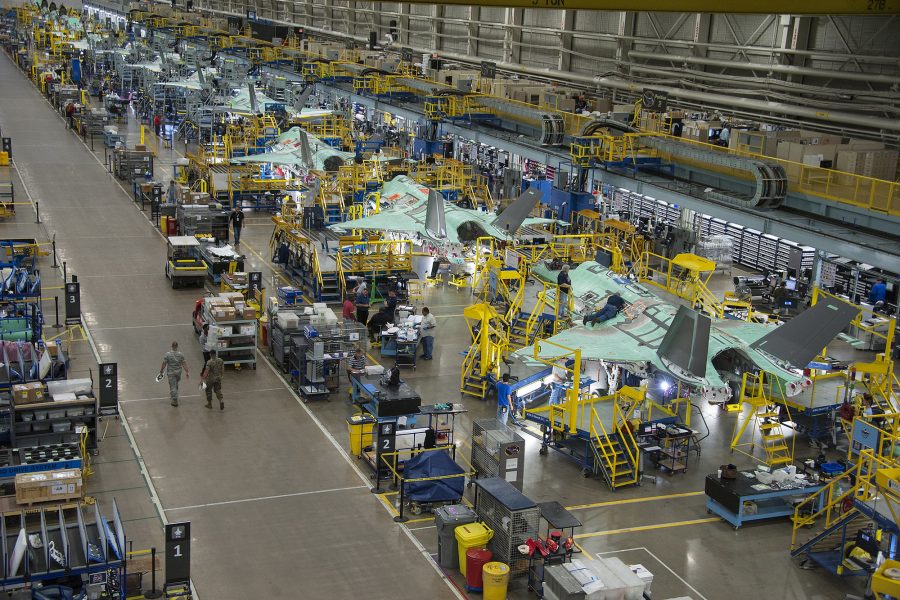Lockheed Martin and the F-35 Joint Program Office have agreed that F-35 production will peak at 156 planes per year in 2023 and remain at that level “for the foreseeable future.”
The JPO and Lockheed Martin have agreed to a “rebaselining” of the program that “ensures predictability and stability in the production process” of the F-35, the company said in a press release.
Lockheed Martin will deliver “133-139 aircraft this year [calendar 2021], 151-153 aircraft in 2022, and anticipates delivering 156 aircraft beginning in 2023 and for the foreseeable future,” it announced. The company did not say how many of each variant will be delivered. Defense officials have said the pre-pandemic goal was to achieve deliveries of 155 airplanes a year by the end of 2022.
The company delivered 120 F-35s in 2020, versus a planned 141, and reduced its planned production this year from 169 to 139. Lockheed Martin officials have chalked up the missed deliveries to supply problems stemming from the COVID-19 pandemic as well as the need to rearrange workspaces and shifts to keep workers appropriately distanced during production. However, production was never halted due to the pandemic.
Late last year, the company said it would not accelerate production to quickly make up the missed deliveries, as that would require a hiring surge or added shifts and create demand for supplied materials that would be disruptive to the rhythm of manufacturing the F-35. At the time, it expected to make up the missed deliveries by the end of 2023.
Bridget Lauderdale, Lockheed Martin vice president and general manager for the F-35, said in June that “many of our suppliers are small businesses. We were very focused during the pandemic on ensuring we were flowing resources [and] money from the U.S. government, to ensure that our small businesses could continue to operate and deliver supply” to the factory. She said the “great news is, the line is stabilizing and the supply base is stabilizing,” and she expected to “ramp back up” in the near future.
A company spokesman said the announcement is not an indication that a deal has been reached on Lot 15-17 negotiations, which continue. Program Executive Officer Air Force Lt. Gen. Eric T. Fick said earlier this month that he hoped to achieve an agreement on Lot 15-17 by the end of October but that negotiations could stretch out longer.
Both Fick and Lockheed Martin have said Lot 15-17 may not see the same year-over-year unit cost reductions in the F-35 because Lot 15 and beyond yield the Block 4 upgrade of the jet, with new and more complex capabilities.
The announcement also does not indicate that the F-35 has achieved “full-rate production” status, usually declared by the Pentagon after a program has satisfied the operational test community that it meets requirements. The Pentagon delayed the declaration of full rate to allow the F-35 to be integrated with the Joint Simulation Environment, a wargaming platform that measures the jet’s performance in highly classified conditions. While establishing a peak production rate for the F-35 is a de facto “full-rate” declaration, absent the official status, the program can’t officially enter into multiyear procurement contracts, which can reduce costs by buying materials in economic quantities. The F-35 partners already benefit from a “block buy” approach similar to a multiyear deal. However, by setting a peak production rate, a multiyear deal may be moot.
The Air Force has signaled that it will buy about five fewer F-35s per year over the next few years, preferring to wait for the Block 4 jets as they start coming off the production line in fiscal 2023. It did not include the F-35 on its “unfunded priorities list” submitted to Congress, which has added 12 jets per year to the Air Force’s request for 48 jets in the last few years.
The Air Force currently fields about 300 of its planned 1,763 F-35s. If it continued to buy the jets at a rate of 48 per year, it would complete its purchases of the fighter in the early 2050s. Original plans called for the Air Force to buy F-35s at a rate of 110 per year starting in the mid-2010s. Current plans do not forecast an Air Force production increase before 2025 at the earliest.
More than 700 F-35s have been delivered to customers worldwide, Lockheed Martin said, and the three variants have amassed more than 430,000 flight hours.
